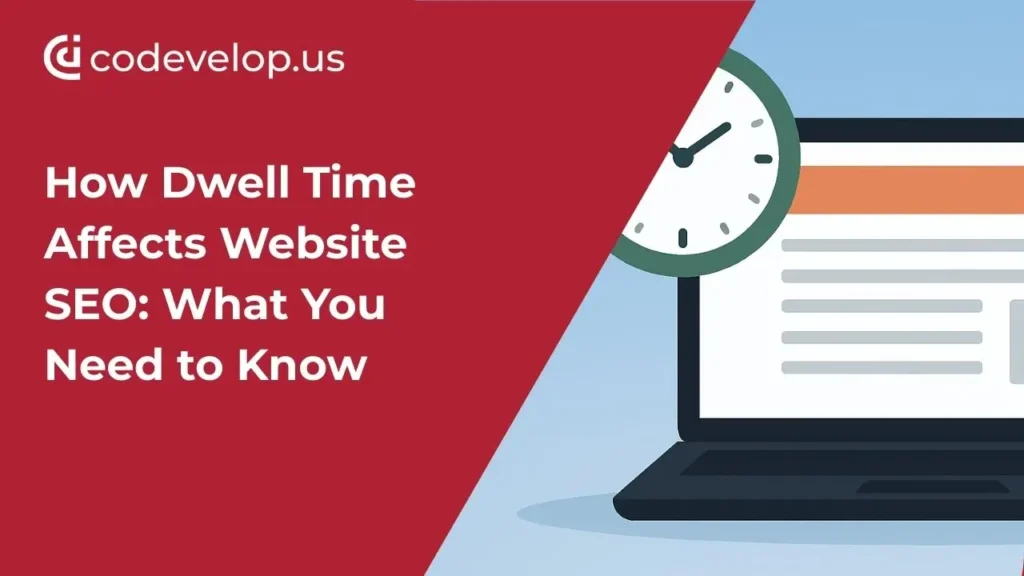If you’ve spent any time reading about SEO, you’ve probably heard people throw around terms like bounce rate, time on site, and dwell time. They sound similar, and to be honest, the industry has done a poor job of explaining the differences clearly. But if you’re trying to rank higher on Google, dwell time is a metric you should pay attention to.
Why? Because dwell time essentially tells search engines how satisfied people are with your website. And in 2025, Google has gotten good at figuring out whether your content is actually helping users—or whether they’re bouncing back to search results in frustration.
At Codevelop, where we focus on SEO strategies and web development, we’ve seen firsthand how improving dwell time can push a website higher in rankings while also converting more visitors into leads.
Let’s break down what dwell time is, why it matters, and what you can do to improve it.
What Exactly Is Dwell Time?
Dwell time is the amount of time someone spends on your page after clicking it from search results, before going back to the results page.
Example:
- A user searches “best roofing contractors in Portland.”
- They click your site.
- If they stick around for 4–5 minutes, reading your content, that’s good dwell time.
- If they leave after 10 seconds and click another result, that’s bad dwell time.
It’s different from:
- Bounce rate: which simply means someone left your page without clicking deeper.
- Time on site: which tracks how long a user spends overall, not just from search results.
Dwell time is more about satisfaction. It signals to Google: “Did this page answer the user’s question?”
Does Google Officially Use Dwell Time as a Ranking Factor?
This is where the debate gets messy. Google doesn’t come right out and say, “Yes, dwell time is a ranking factor.” But here’s the truth:
- Google does measure user signals like engagement, clicks, and pogo-sticking (when users jump back and forth between results).
- Pages with higher engagement tend to rank better.
- UX-focused updates like RankBrain, Core Web Vitals, and Helpful Content Update all align with the idea that dwell time matters.
So while dwell time may not be a “direct ranking factor” in Google’s official lingo, it influences rankings indirectly. If people consistently spend longer on your site than your competitors, you’re going to look better in Google’s eyes.
Why Dwell Time Matters for SEO
Think about it from Google’s perspective. Their job is to serve up the best results for any query. If people are clicking on your site and leaving immediately, it tells Google:
❌ This page didn’t satisfy the user.
But if users click and stay:
✅ This page delivered value and solved their problem.
That positive signal compounds. The longer people dwell, the more likely they are to:
- Explore more pages (lowering bounce rate).
- Share your content.
- Convert into leads or sales.
In other words, dwell time isn’t just an SEO thing—it’s also a business growth thing.
1. Content Quality: The #1 Driver of Dwell Time
If your content is thin, outdated, or feels like a copy-paste job, people won’t stay. It’s that simple.
Improving content to boost dwell time:
- Answer the query completely. Don’t make users hunt for answers.
- Use engaging formatting. Break up walls of text with subheads, bullet points, and visuals.
- Add unique value. Share real examples, insights, or data that competitors don’t.
- Update regularly. Old content that’s irrelevant will kill dwell time fast.
👉 At Codevelop, we help businesses create content that’s both search-optimized and engaging enough to keep users reading.
2. Website Speed & Design: First Impressions Count
Here’s a brutal truth: if your site takes more than 3 seconds to load, many users are gone before dwell time even starts.
Ways to improve:
- Compress images without sacrificing quality.
- Use a fast hosting provider.
- Clean up unnecessary code.
- Make sure the design feels modern and trustworthy.
👉 Codevelop’s web development team specializes in fast, mobile-friendly websites that don’t scare off visitors at first glance.
3. Readability & User Experience
Ever click on a site and see a giant block of text with no breaks? Most people hit “back” instantly.
To improve readability:
- Keep paragraphs short (2–3 sentences max).
- Use H2s and H3s to structure content.
- Add visuals like charts, infographics, or videos.
- Use conversational language (yes, even in technical industries).
When content feels easy to digest, dwell time naturally increases.
4. Internal Linking: Keep People Exploring
Dwell time doesn’t have to mean they stay glued to one page. If they click deeper into your site, that’s just as good.
Example:
A blog on “How Dwell Time Affects SEO” (like this one) could link to:
- SEO services for readers who want expert help.
- Digital marketing solutions for businesses ready to grow online.
- Web development for readers, realizing their site design may be part of the problem.
Smart internal linking extends sessions and boosts dwell time across the board.
5. Multimedia: Video & Interactive Content
Video is one of the best dwell time boosters. A 2–3 minute explainer video keeps users engaged far longer than text alone.
Other ideas:
- Interactive calculators (ROI, pricing, etc.).
- Image sliders or galleries.
- Downloadable guides or checklists.
Google notices when users interact and stay longer.
6. Avoid Clickbait & Thin Pages
Clickbait might get the initial click, but if your content doesn’t deliver, dwell time tanks. Similarly, 300-word “fluff pages” rarely keep anyone’s attention.
Instead:
- Write content in-depth (1,000+ words where appropriate).
- Focus on quality over quantity.
- Deliver exactly what the headline promises.
7. Mobile Optimization: Where Dwell Time Is Won or Lost
More than half of search traffic comes from mobile. If your site is hard to read on a phone, dwell time drops like a rock.
Mobile dwell time boosters:
- Large, readable fonts.
- Easy tap targets (buttons/links).
- Minimal pop-ups that don’t block content.
👉 Our web development team makes sure sites look and function perfectly across devices.
Real-World Example: Two Sites, Two Outcomes
We worked with a client who had strong rankings but couldn’t convert traffic into leads. Their bounce rate was high, and the average time on site was under 30 seconds.
After redesigning their website, updating blog content, and adding videos:
- Dwell time increased by 200%.
- Bounce rate dropped by 40%.
- Leads nearly doubled within six months.
That’s the power of aligning content + design + SEO.
Final Thoughts: Dwell Time Is About People, Not Just Algorithms
At the end of the day, dwell time isn’t just a metric—it’s a reflection of how well your website serves real people.
Google wants happy users. If visitors find value, stay longer, and engage with your site, rankings improve naturally. If not, you’ll slip behind competitors who are doing it better.
So the next time you’re thinking about SEO, don’t just ask, “How do I rank higher?” Ask, “How do I make users stay?”👉 Ready to boost your site’s dwell time and overall SEO performance? Codevelop’s SEO and web development services are designed to attract, engage, and convert visitors into real leads.


